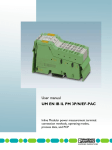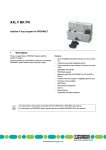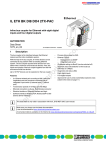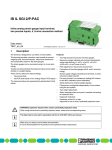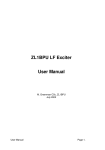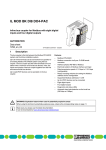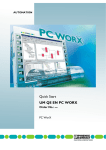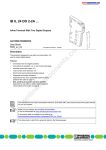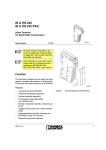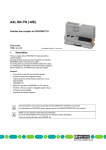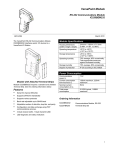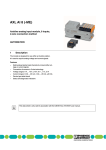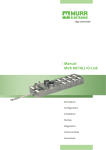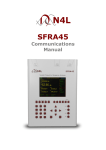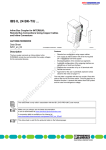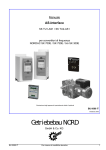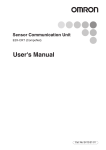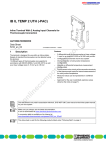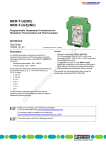Download Data Sheet DB GB IB IL AI 2-HART (-PAC) - Digi-Key
Transcript
IB IL AI 2-HART (-PAC) Inline Terminal With 2 Analog Input Channels and HART Functions 4 x AUTOMATION Data Sheet 6758_en_01 1 © PHOENIX CONTACT - 11/2007 Function Description The terminal is designed for use within an Inline station. It allows communication with smart field devices using the standardized communication protocols INTERBUS and HART. It provides both analog and digital communication. The analog signal transmits the process information. The modulated digital signal enables bidirectional communication to the sensor (with HART capabilities) at the same time. – – – – – – – Hand-held connection possible Measured values can be represented in three different formats 16-bit analog/digital converter Resolution depends on the representation format and the measuring range Diagnostic indication Point-to-point and multi-drop connections possible Approved for the use in potentially explosive areas (observe the notes on page 7) Features – – – – – – Two differential analog signal inputs to connect current signals Sensors are connected using 2-wire technology (active and passive sensors) Two differential analog signal inputs to connect current signals Current measuring range: 4 mA ... 20 mA By default, both channels are set to the measuring range 4 mA to 20 mA (IB IL format) HART protocol transmission using PCP This data sheet is only valid in association with the IL SYS INST UM E user manual or the Inline system manual for your bus system. A function block for easy terminal handling can be downloaded at www.download.phoenixcontact.com. Make sure you always use the latest documentation. It can be downloaded at www.download.phoenixcontact.com. A conversion table is available on the Internet at www.download.phoenixcontact.com/general/7000_en_00.pdf. This data sheet is valid for the products listed on the following page: IB IL AI 2-HART (-PAC) 2 Table of Contents 1 Function Description ................................................................................................................... 1 2 Table of Contents ....................................................................................................................... 2 3 Ordering Data ............................................................................................................................. 3 4 Technical Data............................................................................................................................ 4 5 Local Diagnostic Indicators and Terminal Point Assignment....................................................... 6 5.1 5.2 5.3 Local Diagnostic and Status Indicators........................................................................................................... 6 Function Identification .................................................................................................................................... 6 Terminal Point Assignment............................................................................................................................. 6 6 Installation Instructions ............................................................................................................... 6 7 Notes on Using the Terminal in Potentially Explosive Areas ....................................................... 7 8 Internal Circuit Diagram .............................................................................................................. 8 9 Electrical Isolation....................................................................................................................... 9 10 Connection Notes ....................................................................................................................... 9 10.1 10.2 Connection of the HART Devices For a Point-to-Point Connection .............................................................. 10 Connection of the HART Devices in a Multidrop Network............................................................................. 10 11 Programming Data/Configuration Data ......................................................................................11 12 Process Data .............................................................................................................................11 12.1 12.2 Assignment of the Terminal Points to the Input Data (See page 12) ........................................................... 11 Process Data Input Words (IN)..................................................................................................................... 12 13 Formats for the Representation of Measured Values.................................................................13 13.1 13.2 13.3 13.4 14 "IB IL" Format ............................................................................................................................................... 13 "Standardized Representation" Format ........................................................................................................ 13 "PIO" Format ................................................................................................................................................ 14 Examples for Measured Value Representations........................................................................................... 14 HART Functions of the IB IL AI 2-HART (-PAC) Terminal .........................................................15 14.1 14.2 14.3 14.4 Recommendations For Its Use ..................................................................................................................... 15 HART Communication.................................................................................................................................. 15 HART Operating Mode (Polling/Burst) for Point-to-Point Connections and Multidrop Networks .................. 16 HART Device Addresses.............................................................................................................................. 17 15 Introduction Into FDT Technology..............................................................................................18 15.1 15.2 15.3 15.4 15.5 15.6 6758_en_01 General Information About FDT/DTM........................................................................................................... 18 FDT and AutomationXplorer+....................................................................................................................... 18 FDT and PC WorX........................................................................................................................................ 19 Internet ......................................................................................................................................................... 20 Documentation ............................................................................................................................................. 20 Special Addressing and Connection (e.g., Using a Hand-Held Operating Device) ................................................................................................ 20 PHOENIX CONTACT 2 IB IL AI 2-HART (-PAC) 16 Reading Data Using the HART Protocol ....................................................................................20 17 PCP Communication .................................................................................................................20 17.1 17.2 17.3 17.4 17.5 17.6 17.7 17.8 Object Dictionary.......................................................................................................................................... 21 UNIQUE_IDENTIFIER_CHANNEL1_SLAVE1 ... 5 and UNIQUE_IDENTIFIER_CHANNEL2_SLAVE1 ... 5 Objects ......................................................................... 22 HART_PASS_THROUGH_CHANNEL1 / 2 Object...................................................................................... 23 POLL/BURST_RESPONSE_CHANNEL1_SLAVE1 ... 5 and POLL/BURST_RESPONSE_CHANNEL2_SLAVE1 ... 5 Object .................................................................. 25 PROCESS_DATA_VALUE Object ............................................................................................................... 27 STATUS Object............................................................................................................................................ 28 CONTROL Object ........................................................................................................................................ 29 INIT_TABLE Object...................................................................................................................................... 30 18 Start Behavior ............................................................................................................................32 3 Ordering Data Products Description Type Order No. Pcs./Pkt. Inline terminal with 2 analog input channels with HART functions; complete with accessories (connectors and labeling fields) IB IL AI 2-HART-PAC 2861331 1 Inline Terminal with 2 analog input channels and HART functions; without accessories IB IL AI 2-HART 2860264 1 Pcs./Pkt. The connectors listed below are needed for the complete fitting of the IB IL AI 2-HART terminal. Accessories Description Type Order No. Inline shield connector for analog Inline terminals IB IL SCN-6 SHIELD 2726353 5 Connector for digital single-channel, two-channel or 8-channel Inline terminals IB IL SCN-8 2726337 10 Documentation Description Type Order No. Pcs./Pkt. "Automation Terminals of the Inline Product Range" user manual IL SYS INST UM E 2698737 1 "Configuring and Installing the INTERBUS Inline Product Range" user manual IB IL SYS PRO UM E 2743048 1 "INTERBUS Addressing" data sheet DB GB IBS SYS ADDRESS 9000990 1 "Inline Terminals for Use in Zone 2 Potentially Explosive Areas" application note AH EN IL EX ZONE 2 7217 1 "Peripherals Communication Protocol (PCP)" user manual IBS SYS PCP G4 UM E 2745169 1 "Startup of a HART-Compatible Device in AutomationXplorer+" application note AH EN AUTOMATIONXPLORER & HART 7603 1 6758_en_01 PHOENIX CONTACT 3 IB IL AI 2-HART (-PAC) 4 Technical Data General Data Housing dimensions (width x height x depth) 48.8 mm x 120 mm x 71.5 mm Weight 134 g (without connectors), 206 g (with connectors) Operating mode Process data operation with 2 words and PCP operation with 2 words Transmission speed 500 kbps Connection method for sensors 2-wire technology Power supply of the sensors 24 V DC, provided by the terminal Permissible temperature (operation) -25°C … +55°C Permissible temperature (storage/transport) -25°C … +85°C Permissible humidity (operation/storage/transport) 10 % ... 95% according to DIN EN 61131-2 Permissible air pressure (operation/storage/transport) 70 kPa ... 106 kPa (up to 3000 m above sea level) Degree of protection IP20 Class of protection Class III, IEC 61140 Connection data for Inline connectors Connection type Spring-cage terminals Conductor cross-section 0.2 mm2... 1.5 mm2 (solid or stranded), 24 - 16 AWG Interface Local bus Data routing Supply of the Module Electronics and I/O Through the Bus Terminal/Power Terminal Connection method Potential routing Power Consumption Communications power UL 7.5 V Current consumption from UL 95 mA (typical), 110 mA (maximum) I/O supply voltage UANA 24 V DC Current consumption at UANA 50 mA (typical), 150 mA (maximum) Total power consumption 1.9 W (typical) Analog Inputs Number 2 differential analog inputs Signals/resolution in the process data word (quantization) 0 mA ... 25 mA (PIO format) 0.381 µA/LSB 4 mA ... 20 mA (Standardized representation format) 1.000 µA/LSB 4 mA ... 20 mA (IB IL format) 0.533 µA/LSB Measured value representation in the following formats: IB IL 15 bits with sign bit (see also page 13) Standardized representation 15 bits with sign bit (see also page 13) PIO 16 bits without sign bit (see also page 14) Mean-value generation Using 4, 16, 32 measured values, 16 measured values by default Conversion time of the A/D converter 10 µs, approximately 6758_en_01 PHOENIX CONTACT 4 IB IL AI 2-HART (-PAC) Analog Input Stages of the Current Inputs Input resistance 250 Ω (shunt) Limit frequency (-3 dB) of the input filters 25 Hz Process data update of both channels Bus-synchronous Behavior on sensor failure Going to 0 mA or 4 mA Maximum permissible voltage between analog current inputs and analog reference potential ±10 V (corresponds 40 mA across the sensor resistances) Common mode rejection (CMR) 105 dB minimum Reference: current input signal, valid for permissible DC common mode voltage range 115 dB (typical) Permissible DC common mode voltage for CMR 40 V between current input and FE Maximum permissible current ±40 mA Tolerance Behavior and Temperature Response of the Current Inputs (The error indications refer to the measuring range final value.) TA = 23°C Measuring Range Absolute (Typical) Absolute (Maximum) Relative (Typical) Relative (Maximum) 4 mA ... 20 mA ±10.0 µA ±50.0 µA ±0.05% ±0.25% 0 mA ... 25 mA ±10.0 µA ±50.0 µA ±0.04% ±0.20% Relative (Maximum) TA = -25°C ... +55°C Measuring Range Absolute (Typical) Absolute (Maximum) Relative (Typical) 4 mA ... 20 mA ±28.0 µA ±80.0 µA ±0.14% ±0.40% 0 mA ... 25 mA ±28.0 µA ±80.0 µA ±0.11% ±0.32% Additional Tolerances Influenced by Electromagnetic Fields Type of Electromagnetic Interference Typical Deviation of the Measuring Range Final Value (Current Input) Relative Electromagnetic fields; Field strength 10 V/m According to EN 61000-4-3/IEC 61000-4-3 < ±2% Conducted interference Class 3 (test voltage 10 V) According to EN 61000-4-6/IEC 61000-4-6 < ±1% Fast transients (burst) 4 kV supply, 2 kV input According to EN 61000-4-4/IEC 61000-4-4 < ±1% Safety Equipment Surge voltage Suppressor diodes in the analog inputs Electrical Isolation/Isolation of the Voltage Areas Common Potentials 24 V main power, 24 V segment voltage, and GND have the same potential. FE is a separate potential area. Separate Potentials in the System Consisting of Bus Terminal/Power Terminal and an I/O Terminal Test Distance Test Voltage 5 V supply incoming remote bus/7.5 V supply (bus logic) 500 V AC, 50 Hz, 1 min 5 V supply outgoing remote bus/7.5 V supply (bus logic) 500 V AC, 50 Hz, 1 min 7.5 V supply (bus logic), 24 V supply UANA / I/O 500 V AC, 50 Hz, 1 min 7.5 V supply (bus logic), 24 V supply UANA / functional earth ground 500 V AC, 50 Hz, 1 min I/O / functional earth ground 500 V AC, 50 Hz, 1 min 6758_en_01 PHOENIX CONTACT 5 IB IL AI 2-HART (-PAC) Error Messages to the Higher-Level Control or Computer System Failure of the internal voltage supply Yes Peripheral fault/user error Yes, error message via the IN process data (see page 12) Approvals For the latest approvals, please visit www.download.phoenixcontact.com or www.eshop.phoenixcontact.com. 5 Local Diagnostic Indicators and Terminal Point Assignment T R D H 1 H 2 5.3 Terminal Point Assignment ConTerminal Signal nectors Points 1 1.1 +24 V 1 1.2 +I1 1.3 AGND1 1.4, 2.4 FE 2.2, 2.3 +I1 A I2 -H A R T Assignment Sensor supply channel 1 Current input channel 1 Analog ground channel 1 Shield connection Hand-held operating device Connection channel 1 2 and 3 Not used 4 1.1 +24 V 2 Sensor supply channel 2 1.2 -I2 Current input channel 2 1.3 AGND2 Analog ground channel 2 1.4, 2.4 FE Shield connection 2.2, 2.3 +I2 Hand-held operating device Connection channel 2 1 1 1 .1 1 1 2 .1 1 .2 2 2 2 .2 1 .3 3 3 2 .3 1 .4 4 4 1 4 1 1 2 .1 1 .2 2 2 2 .2 1 .3 3 3 2 .3 6 1 .4 4 4 2 .4 High current flowing through potential jumpers UM and US leads to a temperature rise in the potential jumpers and inside the terminal. To keep the current flowing through the potential jumpers of the analog terminals as low as possible, always place the analog terminals after all the other terminals at the end of the main circuit (sequence of the Inline terminals: see also IL SYS INST UM E user manual or the Inline system manual for your bus system). IB IL AI 2-HART terminal with appropriate connectors Installation Instructions Local Diagnostic and Status Indicators Des. D TR H1, H2 5.2 2 .4 Observe the connection notes on page 9. 1 .1 6 7 5 8 B 0 0 3 Figure 1 5.1 2 2 Color Green Green Yellow Meaning Diagnostics PCP communication status HART communication status Function Identification Green 6758_en_01 PHOENIX CONTACT 6 IB IL AI 2-HART (-PAC) 7 Notes on Using the Terminal in Potentially Explosive Areas Approval According to EC Directive 94/9 (ATEX) II 3G Ex nAC IIC T4 X WARNING: Explosion hazard This Inline terminal conforms to the requirements of protection type "n" and can be installed in a zone 2 potentially explosive area. This Inline terminal is a category 3G item of electrical equipment. Before startup, ensure that the following points and instructions are observed. 1. 2. WARNING: Explosion hazard Only use Inline terminals that are approved for use in potentially explosive areas. 3. Before using an Inline terminal in a zone 2 potentially explosive area, check that the terminal has been approved for installation in this area. 4. For a list of terminals approved for use in zone 2 potentially explosive areas, please refer to the AH EN IL EX ZONE 2 application note. 5. Check the labeling on the Inline terminal and the packaging (see Figure 2). 6. II 3G Ex nAC IIC T4 X Potential routing 4 A maximum for use in Ex areas 7. IBx IL xx xx x Order-No.: xxxxxxx Module-ID: xx HW/FW XX/INTERBUS Figure 2 GL UL xx LISTED 31ZN Proc. Ctrl. Eqpt. For Haz. Locs. Cl. I, Zn. 2, AEx nC IIC T5 Cl. I, Zn. 2, Ex nC IIC T5 Cl. I, Div. 2, Grp. A,B,C,D T5 When working on the Inline terminal, always disconnect the supply voltage. The Inline terminal must only be installed, started up, and maintained by qualified specialist personnel. Install the Inline terminals in a control cabinet or metal housing. The minimum requirement for both items is IP54 protection according to EN 60529. The Inline terminal must not be subject to mechanical strain and thermal loads, which exceed the limits specified in the product documentation. The Inline terminal must not be repaired by the user. Repairs may only be carried out by the manufacturer. The Inline terminal is to be replaced by an approved terminal of the same type. Only category 3G equipment may be connected to Inline terminals in zone 2. Observe all applicable standards and national safety and accident prevention regulations for installing and operating equipment. 5561C001 Typical labeling of terminals for use in potentially explosive areas Restrictions WARNING: Explosion hazard When using terminals in potentially explosive areas, observe the technical data and limit values specified in the corresponding documentation (user manual, data sheet, package slip). WARNING: Explosion hazard Restrictions regarding the Inline system Please make sure that the maximum permissible current of 4 A flowing through potential jumpers UM and US (total current) is not exceeded when using the Inline terminals in potentially explosive areas. 6758_en_01 PHOENIX CONTACT 7 IB IL AI 2-HART (-PAC) 8 Internal Circuit Diagram IN T E R B U S U O P C L + A N A L - U U 2 4 V 2 4 V 2 4 V R E F µ P 2 4 V 5 V E E P R O M 2 4 V 5 V +- 5 V M U X H A R T H A R T + 2 4 V (U S ) + 2 4 V (U M ) 6 7 5 8 A 0 0 7 Figure 3 Internal wiring of the terminal points Key: Protocol chip OPC µ P x x x Supply unit with electrical isolation E E P R O M X X X Analog/digital converter M U X Reference voltage R E F Optocoupler Microprocessor Electrically erasable programmable readonly memory Multiplexer Amplifier H A R T HART Modem Other symbols used are explained in the IL SYS INST UM E user manual. 6758_en_01 PHOENIX CONTACT 8 IB IL AI 2-HART (-PAC) 9 Electrical Isolation 10 Connection Notes ATTENTION: Local bus (IN) Bus interface OPC µC UL UANA 24 V ±5 V +24 V +5 V +24 V +5 V HART 1 Analog input 1 Figure 4 Local bus (OUT) Do not connect voltages above ±10 V to a current input. This damages the module electronics as the maximum permissible current of ±40 mA is exceeded. UL UANA ADC HART 1 HART 2 – A B Electrical isolation between areas A and B – HART 2 Analog input 2 6758B004 Electrical isolation of the individual function areas – – Always connect analog sensors using shielded, twisted-pair cables. Connect the shielding to the terminal using the shield connection clamp. The clamp connects the shield to FE (functional earth ground) on the terminal side. Additional wiring is not necessary. Insulate the shielding at the sensor or connect it with a high resistance and a capacitor to the PE potential. Use a connector with shield connection when installing the sensors. Figure 5 and Figure 6 show the connection schematically (without a shield connection). Connection of the HART Devices Please note that the connections of the HART field devices (slaves) to the Inline-HART terminal differs for point-to-point and multidrop connections (see 10.1 and 10.2). The information can be found in Section "HART Operating Mode (Polling/Burst) for Point-to-Point Connections and Multidrop Networks" on page 16. 6758_en_01 PHOENIX CONTACT 9 IB IL AI 2-HART (-PAC) 10.1 Connection of the HART Devices For a Point-to-Point Connection 1 1 2 1 1 1 1 2 2 2 2 3 3 3 3 4 4 4 4 Address 0 IN 24 V IN Address 0 6758C005 Figure 5 10.2 2 Connection of active sensors (slaves) in 2-wire technology with shield connection Figure 6 6758C006 Connection of passive sensors (slaves) in 2wire technology with shield connection (Loop power) Connection of the HART Devices in a Multidrop Network 1 Address 1 Address 2 Address 3 Slave 1 2 1 2 1 2 1 2 1 1 1 1 2 2 2 2 3 3 3 3 4 4 4 4 Slave 1 Slave 2 Slave 2 Slave 3 Slave 3 Address 6 Address 7 Address 8 24 V Address 4 Slave 4 Slave 4 Address 9 24 V Address 5 Slave 5 Slave 5 Address 10 6758C012 Figure 7 6758_en_01 Connection of sensors (slaves) in a multidrop network PHOENIX CONTACT 10 IB IL AI 2-HART (-PAC) 11 Programming Data/Configuration Data Local Bus (INTERBUS) ID code Length code Input address area Output address area Parameter channel (PCP) Register length (bus) 12 Other Bus Systems DChex (220dec) 02hex 2 words 2 words 2 words 4 words For the programming/configuration data of other bus systems, please refer to the corresponding electronic device data sheet (e.g., GSD, EDS). Process Data For the assignment of the illustrated (byte.bit) view to your INTERBUS control or computer system, please refer to the DB GB IBS SYS ADDRESS data sheet. 12.1 Assignment of the Terminal Points to the Input Data (See page 12) (Word.bit) view Word Bit (Byte.bit) view Byte Bit Channel 1 Signal (connector 1) Signal reference Shield (FE) (Word.bit) view Word Bit (Byte.bit) view Byte Bit Channel 2 Signal (connector 4) Signal reference Shield (FE) 6758_en_01 15 12 11 Byte 0 7 6 5 4 3 Terminal point 1.2 Terminal point 1.3 Terminal point 1.4 15 14 14 13 13 12 11 Byte 0 7 6 5 4 3 Terminal point 1.2 Terminal point 1.3 Terminal point 1.4 10 9 Word 0 8 7 6 2 1 0 6 10 2 2 1 0 5 3 Byte 1 4 3 2 1 0 9 Word 1 8 7 6 5 4 2 1 0 1 0 5 2 1 0 7 7 6 5 4 3 Byte 1 4 3 PHOENIX CONTACT 11 IB IL AI 2-HART (-PAC) 12.2 Process Data Input Words (IN) The measured value 1 (main measured value) is transmitted, per channel, to the controller board or the computer by means of the IN process data input words. Please observe that the content of the IN process data input words 1 and 2 is relevant for point-topoint connections only. In multidrop mode, a current value of 4 mA is indicated. Process data word 2 Process data word 1 Channel 1 Channel 2 Format: MSB LSB 15 14 13 12 11 10 9 8 7 6 5 4 3 2 1 0 8 7 6 5 4 3 2 1 0 IL, Standardized representation AV SB 15 14 13 12 11 10 9 ST 0/4 AV SB OC OR 5564A009 Figure 8 Sequence of the process input data words and display of the bits of the first process data word in the different formats Key SB AV MSB LSB Sign bit Analog value Most significant bit Least significant bit The "IB IL" and "standardized representation" process data formats support extended diagnostics. The following error codes are possible: Code (hex) 8001 8002 8004 8010 8040 8020 6758_en_01 Error Overrange Open circuit Measured value invalid/ no valid measured value available Invalid configuration Terminal faulty Supply voltage not present PHOENIX CONTACT 12 IB IL AI 2-HART (-PAC) 13 Formats for the Representation of Measured Values Please note that the measured values shown are only relevant for a point-to-point connection. In multidrop mode a constant value is always displayed. 13.1 "IB IL" Format The "IB IL" format enables high-resolution representation of measured values in the 4 mA ... 20 mA measuring range. The measured value is represented in bits 14 to 0. An additional bit (bit 15) is available as a sign bit. This format supports extended diagnostics. Values >8000hex and <8100hex indicate an error. The error codes are listed on page 12. Measured value representation in "IB IL" format (15 bits) 13.2 "Standardized Representation" Format The measured values are represented in bits 14 through 0. An additional bit (bit 15) is available as a sign bit. The overrange limits and the open circuit threshold in the higherlevel control system can be freely defined. In this format, data is standardized to the measuring range and represented in such a way that it indicates the corresponding value without conversion. In this format one bit has the value of 1 µA. This format supports extended diagnostics. Values >8000hex and <8100hex indicate an error. The error codes are listed on page 12. Error messages occur according to the "IB IL" format. Open circuit and short-circuit limits can be set with the PCP object called INIT_TABLE. Measured value representation in "standardized representation" format (15 bits) 15 14 13 12 11 10 9 8 7 6 5 4 3 2 1 0 SB AV 15 14 13 12 11 10 9 8 7 6 5 4 3 2 1 0 SB AV SB AV SB AV Sign bit Analog value This format is the default format. To ensure that the terminal can be operated in previously used data formats, the measured value representation can be switched to other formats. Significant Measured Values Some codes are used for diagnostic functions. Therefore, the resolution is not 15 bits, but exactly calculated 14.9886847 bits. Measuring range 4 mA ... 20 mA Input Data Word (Two's Complement) hex dec 8001 Overrange 7F00 32512 7530 30000 0001 1 0000 0 8002 Open circuit 6758_en_01 Sign bit Analog value Significant Measured Values Measuring range 4 mA ... 20 mA Input Data Word (Two's Complement) hex dec 8001 Overrange 4E20 8002 20000 Open circuit 4 mA ... 20 mA IInput mA > +22.5 (default, value can be defined) +20.0 <3.2 (default, value can be defined) 4 mA ... 20 mA IInput mA > +21.339733 +21.3397 +20.0 +4.000533 +4.0 to 3.2 < +3.2 PHOENIX CONTACT 13 IB IL AI 2-HART (-PAC) 13.3 13.4 "PIO" Format PIO format enables high-resolution representation of measured values in the 0 mA ... 25 mA current measuring range. In this format, the measuring range of 0 mA ... 25 mA is divided into 216quantization steps (65 536 steps). Thus, unipolar measured currents with a resolution of 0.38 µA/ LSB can be represented. Signals between 0 mA ... 25 mA can be aquired. Please note that error messages cannot be displayed in this format. Measured value representation in "PIO" format (16 bits) 15 Examples for Measured Value Representations Measured value representation in various data formats. Measured value: 10 mA Process data input word Format IB IL PIO Standardized representation hex dec MeasValue Value ured Value 3A98 15 000 10 mA 6666 26 214 10 mA 2710 10 000 10 mA Measuring Range 4 mA ... 20 mA 0 mA ... 25 mA 4 mA ... 20 mA 14 13 12 11 10 9 8 7 6 5 4 3 2 1 0 AV AV Analog value Significant Measured Values Measuring range 0 mA ... 25 mA Input Data Word (Two's Complement) hex dec F5C2 62914 CCCD 52429 6666 26214 0A3D 2621 0001 1 0000 0 6758_en_01 PIO IInput mA +24.0 +20.0 +10.0 +1.0 +0.3815 µA +0 PHOENIX CONTACT 14 IB IL AI 2-HART (-PAC) 14 14.1 HART Functions of the IB IL AI 2-HART (-PAC) Terminal Recommendations For Its Use The following table contains notes on the use of the terminal depending on your requirements for the application: Application – A HART slave – A measured value per HART slave – – A HART slave Several measured values per HART slave – – – A HART slave Several measured values per HART slave Fastest possible update of the measured value – – Several HART slaves Each HART slave offers the same number of measured values – Unrestricted access to a HART slave HART Communication In accordance with the HART specification, operating devices (masters) send a voltage signal. Field devices (slaves) send their messages via load-independent currents. The current signals are converted to voltage signals at the internal resistance (i.e., its load) of the receiver. The signals are exchanged in accordance with the HART protocol specified by the HART foundation. In accordance with this master/slave procedure, the master initiates any communication activity. Slaves only start transmission upon request (see Figure 9). 6758_en_01 Master command with data, if req. Slave Data between masters and field devices is transmitted by superimposing an encoded digital signal on the 4 mA ... 20 mA current loop. Thanks to the encoding without mean value, simultaneous transmission of the analog signal is not affected. Master 14.2 Recommendation Please use the process data input words (see Section 12 on page 11). These process data input words contain a 16-bit measured signal value ranging from 4 mA ... 20 mA. Use polling mode (see 14.3 on page 16). The terminal cyclically requests measured value from the HART slave using HART communication. These measured values are provided by the terminal. They can be read with a PCP service. Use burst mode (see Section 14.3 on page 16). The HART slave continuously sends measured values using HART communication. These measured values are provided by the terminal. They can be read with a PCP service. Use the polling mode (see 14.3 on page 16). The terminal cyclically requests measured values from each HART slave using HART communication. These measured values are provided by the terminal. They can be read with a PCP service. Use the PASS_THROUGH mechanism (see Section 17.3 on page 23) to directly communicate with each HART device using HART communication. Please note that the HART telegram needs to be imbedded into the PCP telegram. Slave response telegram with data 6758C024 Figure 9 Exchanging HART commands The HART specification allows for two masters, i.e. usually the HART operating device as primary master and a hand-held operator panel as secondary master. The HART commands are transmitted as telegrams that are structured as follows: PHOENIX CONTACT 15 IB IL AI 2-HART (-PAC) . The HART Telegram Structure Preamble x SC AD HC 1 5 1 byte bytes byte BC ST 1 2 byte bytes DA CS xx xxx Key: Preamble: The preamble is used to synchronize the HART devices. SC: Start byte The start byte indicates the sender (master, slave, slave in burst mode) and whether a long or a short address is used. AD: Address Length: 5 bytes = long address 1 byte = short address HC: BC: ST: DA: CS: Via this address the two masters are distinguished, burst telegrams and field devices are identified. HART command The HART command encodes the master's commands. Byte count = ST + DA This byte indicates the number of transmitted status and data bytes. Status The response message of a HART slave contains two status bytes. It indicates whether the data was received without errors (= 0) and the current field device status. Data The maximum data length is 26 bytes, depending on the HART command. Checksum of the entire telegram. Structure of the AD Address for Long Addresses: Long address (5 bytes) Master Burst Bit 31, 30, 29, ...0 Further information on the HART topic can be downloaded from the homepage of the HCF user organization (HART COMMUNICATION FOUNDATION) at www.hartcomm.org The HART protocol can be implemented by any manufacturer and it can be freely used by any user. This open communication protocol between operating and field device is supported by the HART Communication Foundation (HCF). The HCF also provides technical support for the user. Among other things, the HCF monitors the openness of the protocol and manages device descriptions of all devices approved for operation. 6758_en_01 HART and HCF logo 14.3 HART Operating Mode (Polling/Burst) for Pointto-Point Connections and Multidrop Networks Point-to-Point Connection (PTP) For a point-to-point connection, connect a HART field device (slave) to the HART operating device (master). The master communicates with precisely one HART device via one pair of wires. For this reason, the device address "0" must be set for the HART field device (cf. Figure 5 and Figure 6 on page 10). Multidrop Network In a multidrop network, the HART operating device communicates with up to 5 HART field devices being connected in parallel to the master via an individual wire pair each (cf. Figure 7). The device address of each slave determines which slave is addressed by the master. This device address is to be preset according to the range from 1 to 15. Please make sure – NOT to set the device address "0" for slaves – NOT to assign device addresses twice. Burst Mode Operation Burst mode operation is only possible for point-to-point connections. Here the slave is requested by the master to send a standard HART response telegram (burst telegram). This burst telegram is sent continuously by the HART slave until the master cancels the request. The command number of the response is variable and is transmitted via the CONTROL object. This command number is sent to the HART slave via command 108. After this, burst mode operation is enabled via command 109. The current response can be read via the POLL/ BURST_RESPONSE_CHANNEL_x_SLAVE_1 object. In this operating mode a timeout is maintained: If no response telegram is received within 800 ms, the object length is set to 0. When sending the burst command number or the burst enter command, the first status byte of the response is checked. If the HART device responds negatively to commands 108 or 109, the response is made available in PHOENIX CONTACT 16 IB IL AI 2-HART (-PAC) the POLL/BURST_RESPONSE_CHANNEL_x_SLAVE_1 object and the 'Burst trouble' bit is set in the STATUS object. This can be the case when the HART slave does not support burst mode operation. Polling Mode Operation In polling mode operation the Inline-HART terminal automatically sends HART commands to all HART slaves present at the same channel. Only HART commands 1, 2, and 3 are permitted. The current polling response can be read in the POLL_RESPONSE_CHANNEL_x_SLAVE_x object. If a slave sends a faulty HART response to the master, the corresponding slave is polled once again. A total of two polling trials are admissible. After the third faulty response, the object length is set to 0 and the next slave is polled. 14.4 HART Device Addresses Setting the Device Address There are several ways of setting the device addresses: – Use the AutomationXplorer+ or PC WorX software offered by Phoenix Contact or – Set the device addresses with a hand-held operating device (cf. Figure 10) or – Contact the manufacturer of the HART field devices used. The default setting of the device addresses of the field devices is always "0". Therefore the devices are preset to point-to-point operation. For setting the device addresses of a HART field device connect a hand-held operating device to terminal points 2.2 and 2.3: The HART Command Scope 1 2 1 1 2 2 3 3 4 4 IN The scope of possible HART commands depends on the HART field device used. For a list of commands supported by your HART field device, please refer to the devicespecific documentation of the device manufacturer. 6758B013 Figure 10 6758_en_01 Connecting a hand-held operating device for address modification PHOENIX CONTACT 17 IB IL AI 2-HART (-PAC) 15 Introduction Into FDT Technology 15.1 General Information About FDT/DTM FDT (Field Device Tool) is the name of the software specification that standardizes the fieldbus-independent configuration, parameterization, and diagnostics of devices in an automation network. The device manufacturer provides device-specific drivers, the DTMs (Device Type Managers). The DTM of a device contains the device description and a device-specific user interface, for example. The DTM is used to integrate a device into the automation network using an FDT framework application (also known as FDT container software). Phoenix Contact is a member of the FDT Group (www.fdt-group.org). Compatibility of the DTM provided by Phoenix Contact for the IB IL AI 2-HART Inline terminal with FDT specification 1.2 has been tested and certified. Figure 11 6758_en_01 15.2 FDT and AutomationXplorer+ The AutomationXplorer+ software is an FDT framework application, in which DTMs from various manufacturers can be integrated. Point-to-point communication, even beyond network boundaries, enables user-friendly parameterization and diagnostics of devices and sensors/actuators via, e.g., Ethernet, INTERBUS, Profibus, HART, and in future PROFINET IO or IO Link protocol. Figure 11 shows on the left-hand side (Project Tree) the bus structure with the communication, gateway and device DTMs installed. The DTM for the Inline-Profibus bus coupler is shown in the middle part. The Inline-Profibus bus coupler and the Inline station are configured and diagnosed in this part. The DTM catalog is displayed on the right-hand side, sorted by device manufacturers as shown. AutomationXplorer+ PHOENIX CONTACT 18 IB IL AI 2-HART (-PAC) 15.3 FDT and PC WorX FDT function have been integrated into the PC WorX software, the standard IEC-61131 programming environment for control systems from Phoenix Contact. This allows to integrate DTMs from various manufacturers, and Figure 12 6758_en_01 to easily parameterize and diagnose devices and sensors/ actuators, e.g. via Ethernet, INTERBUS, HART and PROFINET IO and in future even via the IO Link protocol. The following figure shows the representation of a HART device in the PC WorX software. HARTdevice in PC WorX PHOENIX CONTACT 19 IB IL AI 2-HART (-PAC) 15.4 Internet AutomationXplorer+ can be downloaded at www.automationxplorer.phoenixcontact.com. Additional information about the software is also provided here. Device-specific DTMs can be downloaded at www.automationxplorer.phoenixcontact.com or www.download.phoenixcontact.com. For DTMs for devices from other manufacturers, please contact the relevant manufacturer. 15.5 Special Addressing and Connection (e.g., Using a Hand-Held Operating Device) In the PC WorX software, you do not need to program devices that you integrated into a bus structure using FDT/ DTM technoloy. These devices only need to be configured. 16 PCP Communication You only need to read this section if you want to create your own function block for the use of HART communication (see also Section 16). For further information on PCP communication, please refer to the IBS SYS PCP G4 UM E user manual. Here you will also find more detailed information on error messages during PCP operation. Documentation The "Startup of a HART-Compatible Device in AutomationXplorer+" application note uses an example to show how a HART-compatible device is handled in the AutomationXplorer+ software (see "Ordering Data" on page 3). 15.6 17 Reading Data Using the HART Protocol In point-to-point operating mode, the main value of the field devices is transmitted as an analog signal (4 mA ... 20 mA) using process data. By default upon delivery, the terminal is configured for data transmission according to the parameters on page 30. You can configure the terminal to meet the requirements of your application. The terminal is configured in PCP mode using the INIT_TABLE object. The programs IBS CMD and Config+ (for standard controller boards) as well as PC WorX (for Field Controllers (FC) and Remote Field Controllers (RFC) and embedded controllers (ILC 3xx)) are available for the configuration and parameterization of your INTERBUS system. For more detailed information, please refer to the following user manuals: IBS CMD SWT G4 UM E, UM QS EN CONFIG+, and UM QS EN PC WORX. To read additional data you may use communications via the HART protocol. In the local bus and in the INTERBUS system, this protocol is implemented using PCP. When using a control system from Phoenix Contact and/or FDT communication: For communications via the HART protocol you can use a function block that supports both, point-to-point as well as multidrop mode. The function block can be downloaded at www.download.phoenixcontact.com. It takes over PCP communication completely. You do not have to read Section 17 „PCP Communication“ . When using other control systems: Create a function block for communications via the HART protocol. Use the information on PCP communication in Section 17. 6758_en_01 PHOENIX CONTACT 20 IB IL AI 2-HART (-PAC) 17.1 Object Dictionary Index 0080hex 0081hex 0082hex 0083hex 0084hex 008Fhex 0090hex 0091hex 0092hex 0093hex 0094hex 009Fhex 00A0hex Data Type String Var of Octet String String Var of Octet String String Var of Octet String String Var of Octet String String Var of Octet String String Var of Octet String String Var of Octet String String Var of Octet String String Var of Octet String String Var of Octet String String Var of Octet String String Var of Octet String String Var of Octet String N 1 1 1 1 1 1 1 1 1 1 1 1 1 L 12 12 12 12 12 58 12 12 12 12 12 58 40 00A1hex 00A2hex 00A3hex 00A4hex 00B0hex String Var of Octet String String Var of Octet String String Var of Octet String String Var of Octet String String Var of Octet String 1 1 1 1 1 40 40 40 40 40 00B1hex 00B2hex 00B3hex 00B4hex 00C0hex 00C1hex 00C2hex String Var of Octet String String Var of Octet String String Var of Octet String String Var of Octet String Array of Unsigned 16 Array of Unsigned 16 Array of Unsigned 16 1 1 1 1 2 2 2 40 40 40 40 2 2 2 00C3hex Array of Unsigned 16 N: L: Number of elements Element length in bytes 6758_en_01 14 2 Meaning Analog values Settings (rescan, polling and burst mode) Terminal configuration rd: wr: Object Name UNIQUE_IDENTIFIER_CHANNEL1_SLAVE1 UNIQUE_IDENTIFIER_CHANNEL1_SLAVE2 UNIQUE_IDENTIFIER_CHANNEL1_SLAVE3 UNIQUE_IDENTIFIER_CHANNEL1_SLAVE4 UNIQUE_IDENTIFIER_CHANNEL1_SLAVE5 HART_PASS_THROUGH_CHANNEL1 UNIQUE_IDENTIFIER_CHANNEL2_SLAVE1 UNIQUE_IDENTIFIER_CHANNEL2_SLAVE2 UNIQUE_IDENTIFIER_CHANNEL2_SLAVE3 UNIQUE_IDENTIFIER_CHANNEL2_SLAVE4 UNIQUE_IDENTIFIER_CHANNEL2_SLAVE5 HART_PASS_THROUGH_CHANNEL2 POLL/ BURST_RESPONSE_CHANNEL1_SLAVE1 POLL_RESPONSE_CHANNEL1_SLAVE2 POLL_RESPONSE_CHANNEL1_SLAVE3 POLL_RESPONSE_CHANNEL1_SLAVE4 POLL_RESPONSE_CHANNEL1_SLAVE5 POLL/ BURST_RESPONSE_CHANNEL2_SLAVE1 POLL_RESPONSE_CHANNEL2_SLAVE2 POLL_RESPONSE_CHANNEL2_SLAVE3 POLL_RESPONSE_CHANNEL2_SLAVE4 POLL_RESPONSE_CHANNEL2_SLAVE5 PROCESS_DATA_VALUE STATUS CONTROL Rights rd rd rd rd rd rd/wr rd rd rd rd rd rd/wr rd INIT_TABLE rd/wr rd rd rd rd rd rd rd rd rd rd rd rd/wr Read access permitted Write access permitted PHOENIX CONTACT 21 IB IL AI 2-HART (-PAC) 17.2 UNIQUE_IDENTIFIER_CHANNEL1_SLAVE1 ... 5 and UNIQUE_IDENTIFIER_CHANNEL2_SLAVE1 ... 5 Objects The UNIQUE_IDENTIFIER_CHANNEL1/2_SLAVE1 ... 5 objects contain the manufacturer's indentification data of the slaves connected to the HART terminal. Object Description Objects UNIQUE_IDENTIFIER_CHANNEL1_SLAVE1 ... 5 UNIQUE_IDENTIFIER_CHANNEL2_SLAVE1 ... 5 Access Read Data type String Var of Octet String Index 0080hex - 0084hex (Channel 1, Slave 1...5) 0090hex - 0094hex (Channel 2, Slave 1...5) Subindex 00hex Length (bytes) 12 bytes Data Device identification The objects with the indices 0080hex-0084hex and 0090hex-0094hex all have the same structure. For every possible HART slave there is a unique identifier object. All 008xhex indices are valid for channel 1, all 009xhex indices are valid for channel 2. With every object, the unique identifiers of the corresponding HART slaves can be read. After power-up, these unique identifiers are read from the HART terminal to all present HART slaves. During this process, the "Scan Active" status bit is set. Byte Assignment of the UNIQUE_IDENTIFIER_CHANNELx_SLAVE1 ... 5 Objects 11 10 9 8 7 6 5 4 3 2 1 0 6758B027 254dez = FEhex Manufacturer Identification Code Device Type Code Number of Preambles Universal Command Revision Transmitter-spec CMD Revision Software Revision Hardware Revision Device Function Flags Device ID Number Device ID Number Device ID Number Figure 13 Byte assignment of the UNIQUE_IDENTIFIER_CHANNELx_SLAVE1 ... 5 objects Error Message of This Object Parameters: Error_Class 08hex Error_Code 00hex Additional_Code Meaning 0021hex A Read service was received. The data is not yet available because the terminal still is in "Scan Active" mode. Please wait until the "Scan Active" bit is set to 0 (see Figure 16 on page 28) 6758_en_01 PHOENIX CONTACT 22 IB IL AI 2-HART (-PAC) 17.3 HART_PASS_THROUGH_CHANNEL1 / 2 Object The HART_PASS_THROUGH_CHANNEL1 / 2 objects map the data of a PCP service to a HART telegram. In this way HART devices can receive HART telegrams directly. Object Description Object HART_PASS_THROUGH_CHANNEL1 / 2 object Access Read, Write Data type String Var of Octet String Index 008Fhex (channel 1) / 009Fhex (channel 2) Subindex 00hex Length (bytes) 58 bytes, maximum Data Mapping the PCP user data to a HART telegram Error Messages of This Object During Write Access Parameters: Error_Class 08hex Error_Code 00hex 08hex 00hex 08hex 08hex 06hex 00hex 00hex 02hex Additional_Code Meaning 0020hex – Polling or burst mode operation active – The message is to activate burst operating mode on a HART slave (command = 109 and data = 1) 0022hex A second Write service was received, without the HART response having been collected by a Read service. 0024hex HART timeout, the addressed HART slave did not answer 0025hex HART communication error 0000hex HART supply voltage not present The error message "(08, 00, 0022)hex" can be disabled int he INIT_TABLE object. It ensures that a Write service to the HART_PASS_THROUGH_CHANNELx object is always followed by a Read service. In case, that two different applications use the HART_PASS_THROUGH_CHANNELx object of the terminal, the service sequence is to prevent response telegrams being overwritten before they have been read. For example, it is to be prevented that application 2 generates a HART telegram the response telegram of which overwrites the response telegram of the HART telegram of application 1 before application 1 has read it. There are two exceptions for which no error message is generated: 1. The preceding Write confirmation contains a negative result. 2. Between the first and the second Write service more than 30 seconds elapse. The time of 30 seconds is to prevent the error message "(08, 00, 0022)hex" in the following case: An application sends a Write service and crashes. After the restart it sends a Write service again. If between these two Write services a time of 30 seconds elapsed, the application is processed without an error message. There is a restriction with regard to the HART response transmission: The master address bit and the burst mode bit from the address field are always set to zero. 6758_en_01 PHOENIX CONTACT 23 IB IL AI 2-HART (-PAC) Mapping the PCP User Data to a HART Telegram HART PCP Write_Request Request telegram 0082hex Command_Code Word 1 Preamble Parameter_Count Word 2 Invoke_ID Word 3 SC Comm._Reference AD Index Word 4 HC Word 5 Subindex Length BC Word 6 Data [1] Data [2] DA Word ... Data [...] Data [...] Checksum Word ... Data [...] Data [...] 6758C020 15 ...................... 8 7 ........................ 0 Figure 14 Mapping the PCP user data to a HART telegram The user data of the PCP Write services are inserted between the preamble and the checksum of a HART request telegram. The start sign must be assigned because this sign contains the information whether the following address is short or long. The same is valid for a HART response telegram. The data of a HART response telegram between preamble and checksum are made available as user data in the PCP read confirmation. The PCP write confirmation is only sent back as soon as the HART response telegram was received by the Inline terminal. Usually this happens after 300 ms. Then the HART response telegram must be read via a PCP read request. Master HART-Slave IL AI 2 HART Write_Reque st to "HART_P ASS_THRO UGH" object HART-Request-Te legram m nse-Telegra Hart-Respo mation Write_Confir Read_R equest to "HART_ PASS_T HROUG H" objec t esponse ith HART-R mation w ead_Confir R 6758B021 Figure 15 6758_en_01 Service sequence between HART operating device (master) and HART field device (slave) PHOENIX CONTACT 24 IB IL AI 2-HART (-PAC) 17.4 POLL/BURST_RESPONSE_CHANNEL1_SLAVE1 ... 5 and POLL/BURST_RESPONSE_CHANNEL2_SLAVE1 ... 5 Object The objects contain response telegrams of the HART devices that – during polling mode operation responded to a request telegram by the master or – are operated in burst mode. Object Description Object POLL/BURST_RESPONSE_CHANNEL1_SLAVE1 ... 5 POLL/BURST_RESPONSE_CHANNEL2_SLAVE1 ... 5 Access Read Data type String Var of Octet String Index 00A0hex - 00A4hex (Channel 1, Slave 1...5) 00B0hex - 00B4hex (Channel 2, Slave 1...5) Subindex 00hex Length (bytes) 40 bytes, maximum Data Measured data The objects with the indices 00A0hex-00A4hex and 00B0hex-00B4hex all have the same structure. For every possible HART slave there is a response object. All 00Axhex indices are valid for channel 1, all 00Bxhex indices are valid for channel 2. With every object, the unique identifiers of the corresponding HART slaves can be read. Since burst mode operation is only admissable for point-to-point connection, a burst response can only be read with index 00A0hex for channel 1 and index 00B0hex for channel 2. The HART response to be read comprises the complete HART telegram format, however without preamble and checksum. In this way, the object has the same format as the PASS_THROUGH object. For an example of a HART response. please refer to page 26. Error Message of This Object Parameters: Error_Class 06hex Error_Code 02hex Additional_Code Meaning 0030hex HART supply voltage not present Check the voltage supply of the Inline HART terminal. Please observe that the measured data structure depends on the polling mode set. For further information, please refer to the HART command overview of the HART Communication Foundation HCF. 6758_en_01 PHOENIX CONTACT 25 IB IL AI 2-HART (-PAC) Example of a HART Response The following example only deals with the response telegram in polling mode operation. Here, only the 3 HART commands 1, 2 or 3 can be selected. The response telegram is structured according to the selected command. The data of a HART response telegram between preamble and checksum are made available as user data in the PCP read confirmation. The object is read with a PCP read request. The content of a read confirmation depends on the selected HART command. Structure of the PCP read confirmation: PCP header HART part 6758_en_01 Byte 1 2 3 4 5 6 7 8 9 10 11 12 13 14 15 16 17 18 19 20 21 22 23 24 25 26 27 28 29 30 31 - 34 35 36 - 39 40 41 - 44 Meaning Message code 1st byte Message code 2nd byte Parameter count 1st byte Parameter count 2nd byte Invoke ID Comm. reference Result 1st byte Result 2nd byte Not used Length Start character Address 1st byte Address 2nd byte Address 3rd byte Address 4th byte Address 5th byte Command Byte count Status 1st byte Status 2nd Byte Data Data Data Data Data Data Data Data Data Data Data (4 bytes) Data Data (4 bytes) Data Data (4 bytes) Command 1 80 81 00 0Bhex = 11dec Command 2 80 81 00 0Chex = 12dec Command 3 80 81 00 14hex = 20dec xx xx 00 00 -0Fhex = 15dec 86hex xx xx xx xx xx 01 07 00 00 PV units code PV 1st byte PV 2nd byte PV 3rd byte PV 4th byte xx xx 00 00 -12hex = 18dec 86hex xx xx xx xx xx 02 Ahex = 10dec 00 00 Current 1st byte Current 2nd byte Current 3rd byte Current 4th byte Percent of range 1st byte Percent of range 2nd byte Percent of range 3rd byte Percent of range 4th byte xx xx 00 00 -22hex = 34dec 86hex xx xx xx xx xx 03 1Ahex = 26dec 00 00 Current 1st byte Current 2nd byte Current 3rd byte Current 4th byte PV units code PV 1st byte PV 2nd byte PV 3rd byte PV 4th byte SV units code SV 1st to 4th byte TV units code TV 1st to 4th byte FV units code FV 1st to 4th byte PHOENIX CONTACT 26 IB IL AI 2-HART (-PAC) 17.5 PROCESS_DATA_VALUE Object This object is only relevant for a point-to-point connection. This object provides measured values that are also contained in the IN process data (see Section 12.2 on page 12). Object Description Object PROCESS DATA VALUE Access Read Data type Array of Unsigned 16 Index 00C0hex Subindex 00hex 01hex 02hex Length (bytes) For subindex 0, the length is 4 bytes. For subindex >0, the length is 2 bytes. Data 1st word for channel 1 2nd word for channel 2 2 x 2 bytes Both channels Channel 1 Channel 2 Please observe that the data read out with this object depends on the addressed HART field device. 6758_en_01 PHOENIX CONTACT 27 IB IL AI 2-HART (-PAC) 17.6 STATUS Object The STATUS object indicates the operating state of each channel of the terminal. Object Description Object STATUS Access Read Data type Array of Unsigned 16 Index 00C1hex 2 x 2 bytes Subindex 00hex 01hex 02hex Length (bytes) For subindex 0, the length is 4 bytes. For subindex >0, the length is 2 bytes. Data 1st word (element) for channel 1 2nd word (element) for channel 2 Both channels Channel 1 Channel 2 Description of an Element/Bit Assignment 15 14 13 12 11 10 9 8 7 6 5 4 3 2 1 0 6758B022 Number of HART-Slaves Figure 16 Scan Active Burst Mode Active Poll Mode Active Analog Supply Fail HART Supply Fail Burst Trouble Assignment of an element of the STATUS object (00C1hex) These two supply voltage error bits are reset after voltage is restored. If the Burst Trouble bit is set, you can set it via an errorfree write access onto the CONTROL object. – – 6758_en_01 The polling modes can be selected depending on the HART field devices used. The data read out with this object depend on the addressed HART field device. PHOENIX CONTACT 28 IB IL AI 2-HART (-PAC) 17.7 CONTROL Object Set the polling mode or burst mode via this object for each channel of the terminal. Object Description Object CONTROL Access Read, Write Data type Array of Unsigned 16 Index 00C2hex 2 x 2 bytes Subindex 00hex 01hex 02hex Length (bytes) For subindex 0, the length is 4 bytes. For subindex >0, the length is 2 bytes. Data 1st word (element) for channel 1 2nd word (element) for channel 2 Both channels Channel 1 Channel 2 Description of an Element/Bit Assignment 15 ReScan Figure 17 14 13 12 11 10 9 8 7 6 Poll command 0: Polling mode not active 1, 2, 3 allowed 5 4 3 2 1 0 Burst command 0: Burst mode not active Assignment of an element of the CONTROL object (00C2hex) Please observe that burst and polling mode cannot be active simultaneously (see also "HART Operating Mode (Polling/ Burst) for Point-to-Point Connections and Multidrop Networks" on page 16). Re-Scan The HART interface is re-initialized via the Re-Scan bit. The UNIQUE_IDENTIFIER... objects are deleted and the scan process is introduced again. In this way, all connected slaves on the affected HART channel are detected. During this process, the Scan Active bit is reset in the STATUS object. The Re-Scan bit is cannot be read back in this object. 6758_en_01 PHOENIX CONTACT 29 IB IL AI 2-HART (-PAC) Error Message of This Object: Error_Class 06hex 08hex Error_Code 02hex 00hex 08hex 00hex 08hex 08hex 08hex 08hex 08hex 08hex 08hex 00hex 00hex 00hex 00hex 00hex 00hex 00hex 17.8 Additional_Code Meaning 0000hex HART supply voltage not present 2020hex No HART slave found at the channel and polling or burst-command <> 0. 2022hex Scan phase active and (polling command <> 0 or burst-command <> 0). 2030hex Polling and burst command (both) <> 0. 2130hex Polling command > 3. 2230hex Re-Scan bit set and polling command <> 0 or burst-command <> 0. 2330hex A bit of the reserved bits 12, 13 or 14 is set. 2040hex Polling command <> 0 and burst mode still active. 2043hex Burst command <> 0 and polling mode still active. 2047hex Burst mode is to be enabled for multidrop environment. INIT_TABLE Object Writing the INIT_TABLE object with a Write service configures the terminal. Object Description Object INIT_TABLE Access Read, Write Data type Array of Unsigned 16 Index 00C3hex Subindex 00hex 01hex 02hex 03hex 04hex 05hex 06hex 07hex : 0Ehex Length (bytes) For subindex 0, the length is 28 bytes. For subindex >0, the length is 2 bytes. Data IB IL AI 2-HART terminal configuration 6758_en_01 14 x 2 bytes Write all elements Analog configuration Limit value for open circuit Limit value for overrange Reserved Reserved System settings Reserved : Reserved PHOENIX CONTACT 30 IB IL AI 2-HART (-PAC) Element Description (Subindex) Analog Configuration Element 15 14 13 12 11 10 9 8 7 6 5 Filter Figure 18 4 3 2 1 0 Format Assignment of the analog configuration element (index 00C3, hex, subindex 1hex) The options in bold are default settings. Code 0 1 2 3 Filter 16-fold mean value No mean-value generation 4-fold mean value 32-fold mean value Code 0 1 2 3 Format IB IL 4 mA ... 20 mA Standardized representation PIO Reserved Open Circuit Element In the "Standardized representation" format this element is used to determine the limit value for open circuit. If the current falls below the limit value the error message open circuit 8002hexis indicated in the IN process data. By default, the value is 3200dec, which corresponds to 3.2 mA. Overrange Element In the "Standardized Representation" format this element is used to determine the limit value for overrange. If the current is above the limit value the Overrange error message 8001hexis indicated in the IN process data. By default, the value is 22500dec, which corresponds to 22.5 mA. System Settings Element 15 14 13 12 11 10 9 8 7 6 5 4 3 2 1 Error message 08, 00, 0022 with PASS_THROUGH objects 0: enable 1: disable Figure 19 0 6758D010 Peripheral Fault: 0: enable 1: disable Assignment of the system settings element (index 00C3, hex, subindex 06hex) The Peripheral Fault that can be switched off, relates to the response of a supply voltage interrupt. Error Messages of This Object If a Write service writes an invalid value to an element, the service will be aborted with a negative confirmation. Here, the parameters are the following: Error_Class 08hex Error_Code 00hex Additional_Code Meaning xx30hex Value is out of range The high byte of the ADDITIONAL_CODE (xx) contains the number of the affected element. If several elements are affected, the highest number is given. If, for example, the "analog configuration" element is written with the value 0001hex, an error message with the ADDITIONAL_CODE 0130hex will be displayed, because the first element is faulty. 6758_en_01 PHOENIX CONTACT 31 IB IL AI 2-HART (-PAC) 18 Duration of the Scan Process For the Worst Case (no HART device present): Start Behavior After power-up, the terminal searches both HART channels for possible slaves. To do this, the HART command 0 at the short addresses 0 up to 15 are sent in ascending order. If the slave already responds to short address 0, the search process is aborted. If not, the search process continues until either the short address 15 is reached or the number of slaves detected equals five. For a command to short address 0, 6 different attempts have been executed where normally only 1 attempt takes place. Burst waiting time 4 seconds 6 messages to addresses 0 6 * 330 ms 1 messages to addresses 1-15 15 * 330 ms = approx. 5 seconds Total = approx. 2 seconds approx. 11 seconds During this process being executed in parallel on both channels of the Inline HART terminal, the Scan Active bit is set. From the detected slaves, the UNIQUE_IDENTIFIER_CHANNEL1/2_SLAVE1...5 objects are read and can then be read via the 008xhex and 009xhex object indices. Among others the UNIQUE_IDENTIFIERx object contains the unique 38-bit address of the HART slave. The UNIQUE_IDENTIFIERx objects are distributed onto the objects in the order in which they are found during the search process. Example: A multidrop network at the HART channel 1 comprises the short addresses 1, 3, 7, 12, and 14. Distribution of the UNIQUE_IDENTIFIER1 objects: Index (hex) 0080 0081 0082 0083 0084 Distribution Description UNIQUE_IDENTIFIER_ CHANNEL1_SLAVE1 UNIQUE_IDENTIFIER_ CHANNEL1_SLAVE2 UNIQUE_IDENTIFIER_ CHANNEL1_SLAVE3 UNIQUE_IDENTIFIER_ CHANNEL1_SLAVE4 UNIQUE_IDENTIFIER_ CHANNEL1_SLAVE5 Slave with short address 1 Slave with short address 3 Slave with short address 7 Slave with short address 12 Slave with short address 14 The number of detected slaves can be read via the STATUS (00C1hex) object. After the search process, the Inline HART terminal waits for 4 seconds for a HART slave to send a burst telegram, if required. This case is possible because some HART slaves save there settings in a non-volatile memory. If a slave is in active burst mode, it contiunes to send burst telegrams after the voltage interrupt. After having received a burst telegram, the Inline HART terminal sends a request telegram to the slave in question in order to switch off burst mode. Only then a search process starts. 6758_en_01 PHOENIX CONTACT GmbH & Co. KG • 32823 Blomberg • Germany • Phone: +49-(0) 5235-3-00 PHOENIX CONTACT • P.O.Box 4100 • Harrisburg • PA 17111-0100 • USA • Phone: +717-944-1300 www.phoenixcontact.com 32
































